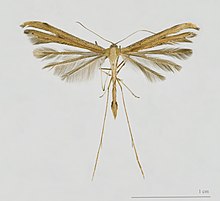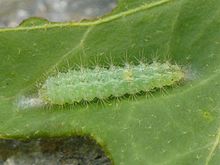| Emmelina monodactyla | |
|---|---|

| |

| |
| Scientific classification | |
| Domain: | Eukaryota |
| Kingdom: | Animalia |
| Phylum: | Arthropoda |
| Class: | Insecta |
| Order: | Lepidoptera |
| Family: | Pterophoridae |
| Genus: | Emmelina |
| Species: | E. monodactyla |
| Binomial name | |
| Emmelina monodactyla (Linnaeus]], 1758) | |
| Synonyms | |
List
| |
Emmelina monodactyla (also known as the T-moth or morning-glory plume moth) is a moth of the family Pterophoridae found in Africa, Asia, Europe and North America. It was first described by Carl Linnaeus in 1758.
Description
For a key to the terms used, see Glossary of entomology terms.The moths fly nearly year-round. They are pale russet in colour, with a wingspan of 18–27 millimeters. The colouration is extremely variable, ranging from off-white with indistinct markings to a strong rust brown. The markings may vary considerably in size. The second and third segments are elongate. The caterpillars are greenish-yellow with a broad green band on the back, and a narrow broken yellow line running down the center. Some specimens may also have a wine-red marking on the back. The colour of the pupae may range from green to reddish brown, sometimes with black markings.
Biology
The larvae feed from May to September in two overlapping generations. They mainly feed on Convolvulaceae species, including hedge bindweed (Calystegia sepium), low false bindweed (Calystegia spithamaea]], sea bindweed (Calystegia soldanella), field bindweed (Convolvulus arvensis), Cantabrican morning glory (Convolvulus cantabrica), Convolvulus floridus, Convolvulus prostratus, dwarf morning-glory (Convolvulus tricolor), sweet potato (Ipomoea batatas), Ipomoea eriocarpa and common morning-glory (Ipomoea purpurea). They also feed on Atriplex species, including common orache (Atriplex patula) and Chenopodium, including fat-hen (Chenopodium album) from the family Amaranthaceae, cardoon (Cynara cardunculus) from the family Asteraceae, and thorn apple (Datura stramonium) and henbane (Hyoscyamus niger) from the family Solanaceae.
Distribution
It is found in Europe, central Asia, Japan, North Africa and North America.
References
- ^ Kimber, Ian. "Common Plume Emmelina monodactyla (Linnaeus, 1758)". UKmoths. Retrieved 2 November 2023.
- Meyrick, E., 1895 A Handbook of British Lepidoptera MacMillan, London pdf
 This article incorporates text from this source, which is in the public domain. Keys and description
This article incorporates text from this source, which is in the public domain. Keys and description
- Gielis, C., 1996. Pterophoridae. - In P. Huerner, O. Karsholt and L. Lyneborg (eds): Microlepidoptera of Europe 1: 1-222. ISBN 87-88757-36-6 ISSN 1395-9506
- Kim, Sora; Byun, Bong-Kyu; Park, Kyu-Tek; Lee, Seunghwan (2010-05-24). "Taxonomic study of the tribe Oidaematophorini (Lepidoptera: Pterophoridae) from Korea, with descriptions of the two new species". Journal of Natural History. 44 (23–24): 1377–1399. doi:10.1080/00222931003679006.
External links
| Taxon identifiers | |
|---|---|
| Emmelina monodactyla |
|



